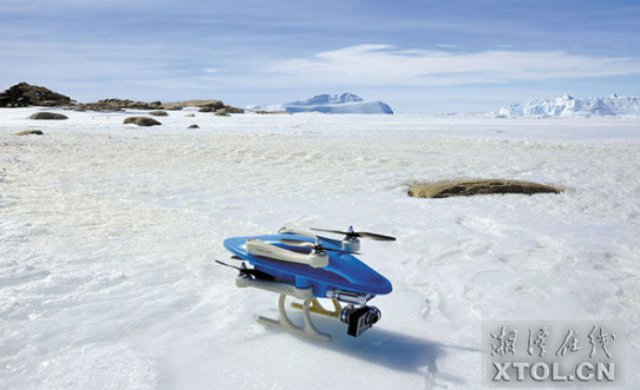 The Chinese Antarctic Expedition Team tested whether 3D printed drones can withstand extreme conditions by taking them to the South Pole to expose it to high altitude and low temperatures at the same time.
The Chinese Antarctic Expedition Team tested whether 3D printed drones can withstand extreme conditions by taking them to the South Pole to expose it to high altitude and low temperatures at the same time.
Six drones, produced by Hunan Mengjing Three Dimensional Technology, Ltd., were taken on the trip and recorded flying through the crisp blue air over fields of gleaming white ice. The blue, grey, and black quadcopter seems perfectly at home in this frozen environment.
Beginning in November of 2014, Professor Liang Jianhong travelled with the 31st research expedition to Antartica in order to use these drones to collect the kind of data only possible to gather from the air. He covered nearly 30,000 nautical miles and worked until March on this project, in an effort to understand what possibilities might exist for the construction of an ice airport.
These drones are significantly more complicated than the typical remote controlled airplane available for purchase at the local hobby store. The design program for the planes required a modified wheel base and a smaller overall size in order to allow them to be easily transported. To allow them to withstand the rugged conditions, special attention had to be paid to the structural integrity of the little creatures without sacrificing their portability or adding over burdensome expense to their production.
The design itself took over a month to develop and 15 days to print, actually a fairly rapid pace considering the requirements. The newly redesigned machine is only one third the size of standard drones, but despite having a volume of only 15x15x45 centimeters this miniaturized version of the typical drone still packs a lot of punch…and a hearty tolerance for the cold, flying in temperatures ranging from 15 to 20 degrees Celsius below zero (5 to -4 degrees Fahrenheit). During this time of flight testing, the unmanned copters were clocked at top speeds ranging between 30 – 40 km/h (18 – 24 mph).
Not only did the drones gather data on the topography of the areas explored by members of the expedition, information about the drones themselves was a valuable research product. Professor Jianhong noted that further improvement in the design was needed to remedy a design flaw that caused an increased possibility for control system malfunctions when the frame is folded for transport.
There are a variety of reasons to begin exploring the possibilities presented by 3D printing drones, rather than fabricating them with traditional techniques and materials. One of the primary reasons is the compressed timeline for production offered through 3D printing. Another factor in the interest in a change, is in the cost required to produce the carbon fiber models that have been traditionally made. Making these available more quickly and with a reduced price tag will significantly expand the types of project in which they can be utilized – and improving the quality of the data that can be gathered and shared. As Jianhong explained:
“It takes three months just to make a set of carbon fiber molds and it costs 20 times more to produce them in carbon fiber than it does via 3D printing. What’s more, the design of the carbon fiber drones can’t be modified as needed.”
This capacity for specific modification means that increasingly specialized drones can be produced, yet again broadening the possibilities for their utilization. Drones have gotten a lot of bad press recently because of the possibilities for using them as part of an advanced weaponry system, but as this expedition to Antartica has demonstrated, technology is as humane as the hands of those who operate it and it clearly has peaceful applications. Professor Jianhong has brought back his observations to the team at Hunan Menging in order to work together for the further improvement of the design, and they have already used powder processing 3D printing to create parts for future experiments.
Source: 3D Print
